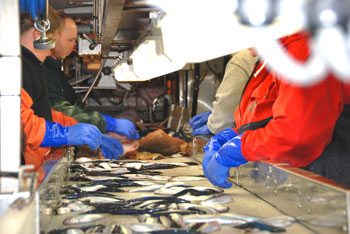What Eats What?

Scientists sorting fish on a conveyor belt aboard the research vessel Bigelow. NOAA photo.
Predation in the 2018 Atlantic Herring Stock Assessment
This year fishery researchers in the region are conducting a benchmark stock assessment for Atlantic herring. A benchmark assessment is comprehensive, and is conducted by a working group of fishery experts. An independent panel of fishery experts is convened to review their work, and they accept or reject the results. If the results are accepted they can be used by fishery managers to set catch limits and to develop fishing rules.
A Diverse Role in the Ecosystem
Atlantic herring are an important forage fish within the marine ecosystem. This small pelagic species lives in big schools and is an important food for other fish, tunas, sharks, marine mammals, and birds. They are also harvested by humans for food, livestock feed, and lobster bait.
An accurate estimate of natural mortality is key to an accurate estimate of population abundance. Natural mortality includes death from something other than fishery harvest. The 2018 Atlantic herring assessment is explicitly accounting for how much Atlantic herring is consumed by predators in the estimate of natural mortality. One way that researchers understand the effects of predation is by studying the food chain: what eats what.
What Eats What: The Food Web Dynamics Program
The Northeast Fisheries Science Center’s Food Web Dynamics Program collects data about predators and prey: what eats what. Each year, these researchers collect and analyze the stomachs of fish caught onboard the NEFSC scientific bottom trawl survey. At right, fish are sorted for sampling during one of the bottom trawl surveys aboard the NOAA Ship Henry Bigelow.This program started in 1973 and has collected more than 650,000 stomachs from more than 150 species.
During research cruises, biologists remove the stomach from the fish, identify the contents, and count the number of prey items. They identify the prey as precisely as possible. Sometimes it’s down to species, sometimes not. It can be a challenge to identify partially digested samples! At the end, we have a picture of what and how much is eaten. Sampling all of these stomachs has shown that many fish that live on the Northeast Continental Shelf are opportunistic eaters. They definitely have favorites, but also generally eat whatever prey is available.
Atlantic Herring Predators: How Much Do They Eat?
For this stock assessment, scientists from the Food Web Dynamics Program assessed what’s eating Atlantic herring. Their study included 12 predator species (skates, spiny dogfish, hakes, and other groundfish) and estimated their rate of Atlantic herring consumption by year. Removals by predators ranged from 32,700 metric tons in 1983 to 390,000 metric tons in 2008 and matched a general increase in the Atlantic herring population over that time. Other studies by the NEFSC show that predators from Georges Bank and the Gulf of Maine had more Atlantic herring in their stomachs in the fall, while Southern New England and the Mid-Atlantic Bight predators ate more herring in the spring.
Data on consumption by predators adds to our knowledge of natural mortality, which in turn provides a better understanding of the marine environment and fish populations. In this image (above), sampling a silver hake stomach revealed its prey: another silver hake. So now we know they are cannibals! Food web dynamics research also demonstrates the responses each species might have to changes in the ecosystem over time. Atlantic herring and their predators will experience changes their distribution, growth, and natural mortality. Predators that eat herring will eat more herring in some years, and less in others because they are opportunistic eaters. This research provides more detail about stock condition and how factors other than fishing that might affect it.
